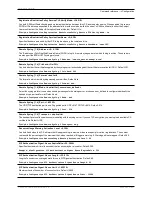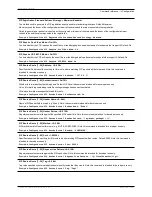
Call Services CallsToUnknownIPAddresses: <Off/Direct/Indirect>
The way in which the VCS attempts to call systems that are not registered with it or one of its neighbors. Default: Indirect.
Direct
: allows an endpoint to make a call to an unknown IP address without the VCS querying any neighbors. The call setup would
occur just as it would if the far end were registered directly to the local system.
Indirect
: upon receiving a call to an unknown IP address, the VCS will query its neighbors for the remote address and if permitted will
route the call through the neighbor.
Off
: endpoints registered directly to the VCS may only call an IP address of a system also registered directly to that VCS.
Example:
xConfiguration Call Services CallsToUnknownIPAddresses: Indirect
Call Services Fallback Alias: <S: 0, 60>
Specifies the alias to which incoming calls are placed for calls where the IP address or domain name of the VCS has been given but no
callee alias has been specified.
Example:
xConfiguration Call Services Fallback Alias: "reception@example.com"
DNS PerDomainServer [1..5] Address: <S: 0, 39>
The IP address of the DNS server to use only when resolving hostnames for the associated domain names.
Example:
xConfiguration DNS PerDomainServer 1 Address: "192.168.12.1"
DNS PerDomainServer [1..5] Domain1: <S: 0, 39>
The first domain name to be resolved by this particular DNS server.
Example:
xConfiguration DNS PerDomainServer 1 Domain1: "dept.example.com"
DNS PerDomainServer [1..5] Domain2: <S: 0, 39>
The second domain name to be resolved by this particular DNS server.
Example:
xConfiguration DNS PerDomainServer 1 Domain2: "other.example.com"
DNS Server [1..5] Address: <S: 0, 39>
The IP address of a default DNS server to use when resolving domain names. You can specify up to 5 servers. These default DNS
servers are used if there is no per-domain DNS server defined for the domain being looked up.
Example:
xConfiguration DNS Server 1 Address: "192.168.12.0"
ErrorReport Contact: <S: 0, 128>
An optional contact email address for follow up on incident reports if required.
Example:
xConfiguration ErrorReport Contact: "bob smith"
ErrorReport CoreDump: <On/Off>
Determines whether diagnostic core dump files are created. Default: On.
Example:
xConfiguration ErrorReport CoreDump: On
ErrorReport Mode: <On/Off>
Determines whether details of application failures are automatically sent to a web service. Default: Off.
Example:
xConfiguration ErrorReport Mode: Off
ErrorReport Proxy: <S: 0, 128>
An optional proxy server to use for the HTTP/HTTPS connections to the incident reporting server.
Example:
xConfiguration ErrorReport Proxy: https://proxy_address/submiterror/
ErrorReport Url: <S: 0, 128>
The URL of the web service to which details of application failures are sent. Default: https://cc-
reports.cisco.com/submitapplicationerror/
Example:
xConfiguration ErrorReport Url: https://cc-reports.cisco.com/submitapplicationerror/
Cisco VCS Administrator Guide (X8.1.1)
Page 431 of 507
Reference material
Command reference — xConfiguration
















































